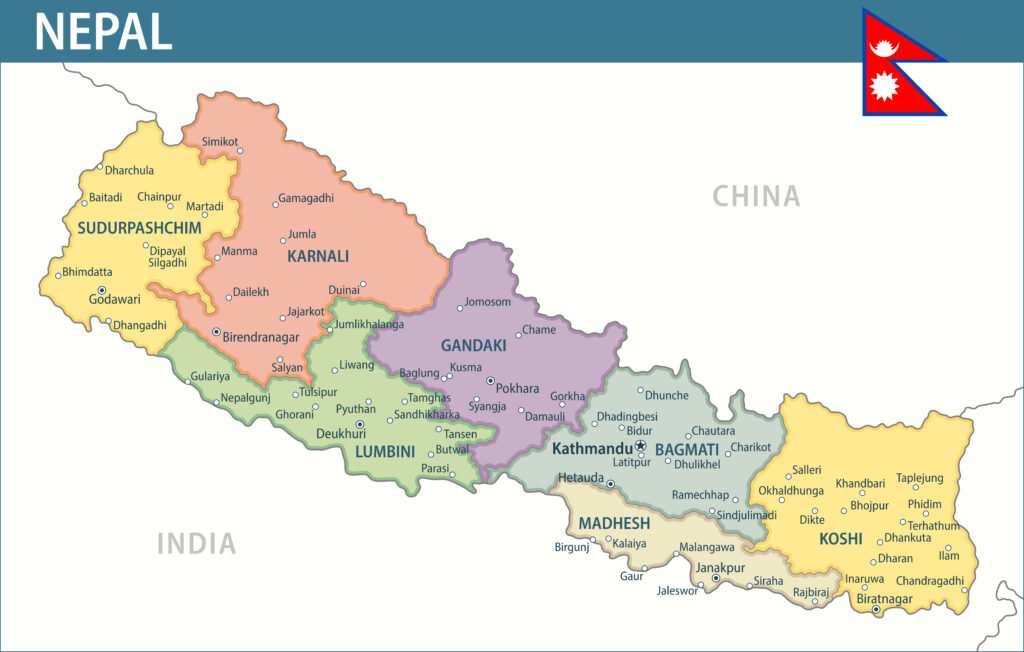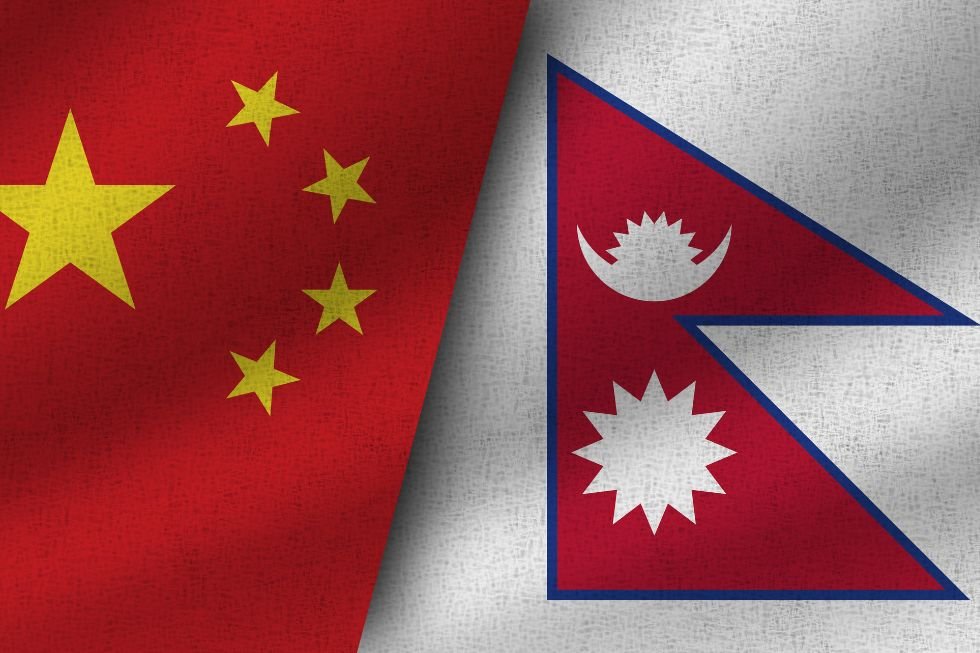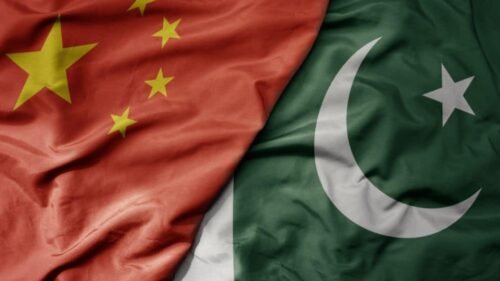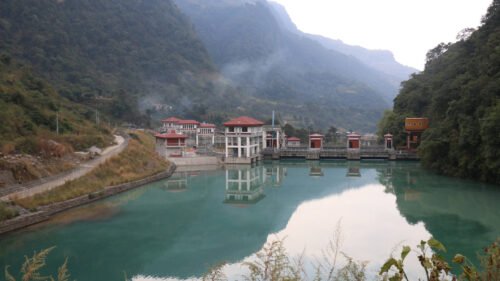As the first rays of daylight filter over the hills surrounding Pashupatinagar — a Nepali border town in the Ilam District adjoining India’s West Bengal — the summer rain turns them a luminous green. The marketplace wakes in a manner that feels distinctly transformed.
The soundscape of the bazaar, once dominated by the intermingling tones of Nepali and Hindi, now finds itself interspersed with the measured intonations of Mandarin. This is a reflection of shifting trade flows: Pashupatinagar sits along one of the most important crossing points between Nepal and India, but it now finds itself increasingly oriented toward China.

Shopkeepers such as Lal Bahadur Gurung steadily watch as the loading zones swell with goods stamped in Chinese characters. He notes with a mix of resignation and pragmatism that trucks from the Chinese side, rather than the Indian, have become the norm, and that mistakes in documentation appear to be overlooked by Nepali officials, a sign of how quietly the commercial hierarchy is being rearranged.
The subtlety of these shifts does not diminish their importance. Commerce here is now paved not only with physical goods but also with the reconfiguration of local allegiances and economic dependencies. China has moved beyond the role of a mere trading partner, increasingly asserting itself as the axis along which commerce, population flows and, more quietly, new ideas and expectations traverse the mountains.
Tea and commerce at a crossroads
The transformation of Pashupatinagar mirrors a broader shift in the economic lifelines of eastern Nepal. One sector that illustrates this change vividly is the tea industry. In eastern Nepal, the Ilam region, famed for its rolling tea gardens, has seen the direction of tea exports shift northward.
Tara Adhikari observes that whereas Kolkata in India was once the default destination, Chinese buyers now offer more lucrative deals. Nepal’s exports of tea to China nearly doubled to 15.7 tonnes during the 2023 fiscal year, though they remain vulnerable to bureaucratic hurdles and bilateral political shifts.
Across the border, the slow decline of the tea industry in the Darjeeling district has been decades in the making. Once celebrated as the “Champagne of teas,” Darjeeling’s delicate muscatel brew commanded premium prices in Europe and Japan. Over the past two decades, however, production volumes have dwindled, labor unrest has flared and younger generations have turned away from the low wages and physically demanding work of plantations.
The rise of cheaper teas from Kenya and Nepal, some falsely sold as Darjeeling, has undercut both prices and prestige, while climate change has disrupted rainfall patterns and shortened the plucking season. Compounding the crisis is the ongoing demand for Gorkhaland autonomy, which has led to repeated strikes and shutdowns, leaving tea gardens stranded in bureaucratic limbo. Many estates now lie neglected, their machinery rusting, their slopes overgrown and their workers caught in a twilight zone between heritage and hardship.
What was once the pride of the Eastern Himalayas is today a fragile legacy, still fragrant but fading. Uncertainties of bureaucratic regulation and the inherent vulnerability to the oscillations of bilateral diplomacy accompany these commercial relationships, yet they come with complexities for profit.
Local anxieties are sharpened by the realization that a downturn in Beijing-Kathmandu relations could translate directly into reduced incomes for Nepali producers, prompting urgent questions about who, if anyone, can safeguard their interests amid great power politics.
Darjeeling’s Gorkhas: kinship, identity and rising ambivalence
Shifts in trade and commerce are also reshaping identity across borders. In Darjeeling and Kalimpong, communities feel the strain of China’s growing presence. These Gorkha communities have long understood identity through kinship and shared history rather than strict national lines. That ethos, rooted in the tradition of joint military service to India and Nepal through the Gorkha regiments of the Indian Army, now contends with new realities.
Havaldar Prem Singh Subba, a retired noncommissioned officer (NCO) of the 11th Gorkha Rifles, laments the blurring of these once-firm affiliations. He notes that China’s approach has achieved proximity without confrontation.
For students in Ilam, just 50 km from the Indian border, the prospect of education in Chinese cities such as Chengdu is now real. This has been made possible by an expansion of Chinese scholarships, which have supported over 6,400 Nepali recipients since the onset of the Belt and Road Initiative (BRI) in 2013. These programs often cover tuition, housing and even laptops.
The question lingers in these hills: if too many are lured away by China’s opportunities, who will maintain the continuity of the mountain homelands?
Confucius Institutes and Beijing’s soft power in Kathmandu
From identity in the hills to education in the capital, China’s influence reaches deeply into Nepalese society. Within Kathmandu University, one of Nepal’s leading higher education institutions, the melodic cadence of Mandarin is no longer a rarity but a regular feature of academic and student life. Since the founding of Nepal’s Confucius Institute in 2009, thousands of Nepalis have taken Chinese language courses and participated in programs facilitating cultural exchanges.
Many Nepali students report that, compared to what is available through Indian partnerships, Chinese scholarships are more generous. This broad-based educational outreach is a manifestation of Beijing’s effort to exercise soft power and shape the worldview of Nepal’s rising generation.
However, these benefits are not unconditional. Political topics that touch on contentious issues such as Tibet, Xinjiang or Hong Kong remain off-limits, a tacit indicator that China’s embrace imposes its boundaries on educational discourse.
Pokhara’s international airport: a monument to debt
Vast infrastructure investments match educational and cultural outreach. Among them, few projects are as symbolic as Pokhara’s International Airport. On the tranquil shores of Lake Phewa, the construction of Pokhara International Airport stands as a potent symbol of Nepal’s closer economic integration with China.
Its gleaming infrastructure is emblematic of a partnership that is transforming the landscape. This modern airport was completed with a $216 million loan from China’s Export-Import Bank, accounting for three-fourths of the total cost at an interest rate of 2%.
Although the project was celebrated as a milestone in Nepali ambitions for economic growth, its cavernous terminal now often sits devoid of travelers. Meanwhile, Nepal’s external debt soared to $10.5 billion in September 2024, with much of it coming from China. In March 2013, this debt was merely $3.5 billion, which means it has grown threefold in a little over 11 years.
For local observers and international analysts alike, this rising debt is a matter of great concern. Some draw parallels to Hambantota Port, the control of which the Sri Lankan government transferred to China when Colombo was unable to pay back Beijing’s debt.
The security dimension: Nepal’s growing military-to-military ties with the PLA
If infrastructure represents economic alignment, the military dimension demonstrates strategic recalibration. The evolution of Nepal’s military relationship with China has unfolded with remarkable speed over the past decade. Throughout the 2000s, Chinese engagement with the Nepalese Army was limited in scale, comprising sporadic material donations and occasional training programs.
This relatively low-key involvement gave way to more substantive collaboration starting in 2008. By 2017, Nepal and China had inaugurated their first-ever joint military exercise, the Sagarmatha Friendship exercise, which took place over ten days at the Special Forces Brigade in Kathmandu. The focus was on counterterrorism and urban warfare tactics.
Over the years, the scope, frequency and sophistication of joint maneuvers have all increased. In September 2024, the Mount Everest Friendship joint military drill was conducted in Chongqing, drawing specialized units from both militaries together for ten days of intensive training. The exercises spanned a wide variety of mission profiles, urban counterterrorism, rapid deployment, improvised explosive device detection, checkpoint operations, infiltration, armed rescue, humanitarian relief, disaster management and peacekeeping scenarios.
Official accounts from both Nepal and China describe these events not only as means of tactical improvement but also as opportunities to cement deep communication channels and foster a durable framework for long-term cooperation and regional stability.
Alongside these drills, Nepali officers increasingly train in Chinese institutions, gaining exposure to Chinese organisational methods, logistics and infrastructure management. In spring 2024, the People’s Liberation Army (PLA) offered to supply Nepal with armored vehicles and to build an ammunition plant inside Nepal, further broadening the military-industrial partnership.
Other forms of support, from donations of medical and disaster relief equipment to collaborative work on logistics and communication projects, have also proliferated, with Nepal’s army leadership repeatedly expressing gratitude to the PLA for its assistance in public statements.
While this deepening engagement is officially presented as a positive step in bilateral defense cooperation, many regional analysts view it as a significant instance of China exercising “soft balancing” in South Asia. This is a strategy aimed at reducing India’s longstanding military influence over Nepal.
Indian strategists warn that Chinese investments in Nepali security infrastructure — whether roads, logistics hubs or communications systems — carry long-term implications and might, in the event of a crisis, allow China to exert far more substantial influence over Nepali internal security decisions.
Mountain frontiers: Humla and the shadow of encroachment
The risks of alignment are not only economic or military but also territorial. Nowhere is this clearer than in Nepal’s far west.
The remoteness and tranquillity of Humla District, in far-western Nepal along the border with the Tibet Autonomous Region of China, heighten the impact of outside intervention. Here, concepts of sovereignty are inscribed in the memory of boundary stones, the regulation of grazing rights and the oral histories of its villagers.
Maya Devi Rokaya, a veteran resident of Limi village, recounts how the Chinese presence did not first appear with soldiers but with construction workers. When villagers protested the building of eleven concrete houses on what they insisted was Nepali soil, Kathmandu, Nepal’s capital, remained conspicuously silent.
The villagers were urged to keep their objections quiet, for, in the calculus of power, antagonizing Beijing seemed inadvisable. Younger locals, such as Dorje Lama, whose livelihoods once depended on cross-border trade, observe that their landscape has undergone a shift with the appearance of new concrete deposits and the mysterious disappearance of historical boundary markers.
Reports by independent researchers and satellite imagery confirm villagers’ claims of Chinese-built structures inside Nepali territory. The absence of an official response from Kathmandu highlights Nepal’s hesitancy to challenge its northern neighbor.
Historical ties: Nepal and Tibet through war, trade and faith
This hesitancy cannot be understood without recalling the deep historical ties between Nepal and Tibet, which long shaped the Himalayan order.
Nepal’s relationship with Tibet is centuries old. The spread of Buddhism from Nepal to Tibet during the Licchavi dynasty in the seventh century, facilitated by the diplomatic marriage of King Amsuvarman’s daughter to the Tibetan king Songtsen Gampo, established not only a religious bond but also a lasting cultural exchange.
Nepalese artisans and monastic scholars played a vital role in transmitting Mahayana Buddhist traditions to Tibet, and the cultural exchange continued as monks and merchants moved back and forth, contributing to a rich hybridization in art, language and spiritual practice.
The historical foundation of this bond was further strengthened and complicated by commerce. For centuries, Tibet’s need for foodstuffs and manufactured goods and Nepal’s hunger for Himalayan salt, wool and livestock gave rise to profitable, arduous trade through perilous high passes at Kuti and Kerung. These routes lay within the control of Nepali rulers, a fact that both fostered mutually beneficial relationships and served as a frequent source of tension, especially during efforts to monopolize trade or assert control through taxation.
Conflict was ever a shadow at the margins of this partnership. Three major wars erupted between Nepal and Tibet in 1788, 1791 and 1855, each culminating in significant diplomatic treaties. The first conflict concluded with the Treaty of Kerung in 1789, following which Nepal withdrew its forces in return for annual payments and exerted de facto control over key India-Tibet trading routes. Noncompliance by Tibet prompted a resumption of hostilities.
In 1792, with the intervention of the Qing dynasty, the Treaty of Betrabati established new protocols, including quinquennial tribute missions to Beijing, a joint commitment to maintain agreed-upon borders and an understanding that the Chinese imperial court would mediate future Kathmandu-Lhasa disputes. Nepal formally acknowledged Chinese suzerainty over Tibet and agreed to submit to the terms of the Qing emperor.
The 1855 war led to the Thapathali Treaty, conferring on Nepal significant commercial privileges in Lhasa and the continued right to send tribute missions. The Newar community in Lhasa became key players in commerce, culture and the spiritual life of Tibet, straddling the boundaries between Hindu and Buddhist traditions.
The 1950 Chinese takeover of Tibet dramatically reshaped these longstanding relationships. Nepalese traders found themselves expelled from Tibet, and the historic trade passes fell silent. It was not until China’s economic reforms in the 1980s that these borders began to open cautiously once more.
Today, the revitalized Kerung-Rasuwa route serves as the principal gateway for trade between Nepal and China, echoing but fundamentally altering the balance that once defined trans-Himalayan commerce.
Political shifts and modern trade realignment
The echoes of history reverberate in Nepal’s modern trade strategy, which must constantly adjust to shifting power dynamics.
The necessity of accommodating new power dynamics has left Nepal in a perennial state of balancing. The closure of traditional Sikkim routes, the construction of new roads and changing dominance between China and India have all informed Nepal’s evolving diplomatic strategy. Following Tibet’s annexation, Kathmandu formally recognized Tibet as part of the People’s Republic of China, even as informal ties persisted through the migration of Tibetan refugees after 1959.
Modern trade statistics reflect a complicated picture of growth and imbalance. In the most recent fiscal year, Nepal’s trade with China expanded markedly, with exports to China rising by over 50% and imports from China growing by more than a third. Border trade surpassed $709 million in the 11 months ending in July 2024, up from $300 million the previous year, following the reopening of major border points at Rasuwagadhi-Kerung and Tatopani-Zhangmu.
Despite these increases, Nepal remains acutely aware of the fragility that comes from this dependence, especially given the persistent trade deficit and vulnerability to non-economic factors.
The contemporary balancing act
All these threads — commerce, culture, security, history — converge in Nepal’s ongoing struggle to balance its relationships with its two powerful neighbors.
In the present moment, Nepalese political discourse is replete with debate over the risks of “being the dynamite between two elephants.” Local practices reflect persistent ambiguity: in border towns, Indian rupees circulate alongside Nepali notes, and Chinese digital payment platforms make steady inroads.
Meanwhile, India’s attempts to counterbalance this shift through measures such as investment in infrastructure and energy projects proceed but are often hampered by bureaucratic and logistical delays. Remittances and dependence on Indian markets continue to provide the foundation of Nepal’s economic stability, but the rise of China as a strategic and economic patron has shifted the national gaze northwards.
Nepal’s search for equilibrium between its two powerful neighbors, long mediated by the dynamism of its unique relationship with Tibet, encapsulates a narrative of continuous adaptation and transformation. The country’s willingness to diversify its economic, educational and military ties to China must be understood within the larger context of strategic necessity: deepening military exercises and economic partnerships with Beijing have been pursued as a hedge against overreliance on India.
Yet, these ties come with new forms of risk, especially as China’s infrastructure, loans and influence in border regions expand. The integrity of Nepal’s sovereignty is now threatened less by dramatic invasions than by the slow, persistent assertion of influence. As the villagers of Humla have learned, sovereignty can sometimes be eroded not by gunfire but through concrete, incremental encroachment.
How Nepal manages this delicate balancing act — navigating the competing interests of its neighbours, maintaining vigilant oversight of border communities and sustaining the cultural threads that have always tied it to both Tibet and India — may ultimately determine not only the country’s future but also the shape of Himalayan geopolitics in the coming century.
[Shokin Chauhan first published a version of this piece on Substack.]
[Kaitlyn Diana edited this piece.]
The views expressed in this article are the author’s own and do not necessarily reflect Fair Observer’s editorial policy.
Support Fair Observer
We rely on your support for our independence, diversity and quality.
For more than 10 years, Fair Observer has been free, fair and independent. No billionaire owns us, no advertisers control us. We are a reader-supported nonprofit. Unlike many other publications, we keep our content free for readers regardless of where they live or whether they can afford to pay. We have no paywalls and no ads.
In the post-truth era of fake news, echo chambers and filter bubbles, we publish a plurality of perspectives from around the world. Anyone can publish with us, but everyone goes through a rigorous editorial process. So, you get fact-checked, well-reasoned content instead of noise.
We publish 3,000+ voices from 90+ countries. We also conduct education and training programs
on subjects ranging from digital media and journalism to writing and critical thinking. This
doesn’t come cheap. Servers, editors, trainers and web developers cost
money.
Please consider supporting us on a regular basis as a recurring donor or a
sustaining member.
Will you support FO’s journalism?
We rely on your support for our independence, diversity and quality.









Comment